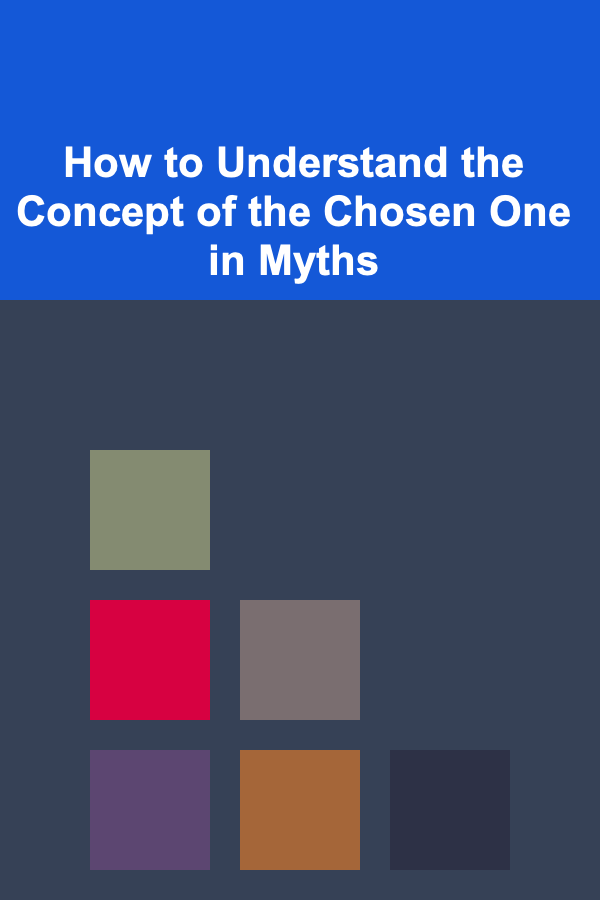
How to Understand the Concept of the Chosen One in Myths
ebook include PDF & Audio bundle (Micro Guide)
$12.99$8.99
Limited Time Offer! Order within the next:

The figure of the Chosen One is a staple in mythologies, religions, and modern pop culture. Often portrayed as a character marked by destiny or divine favor, the Chosen One plays a pivotal role in shaping the narrative, whether in ancient texts, epic sagas, or contemporary stories. But what does it truly mean to be "the Chosen One"? How has this concept evolved, and why does it continue to resonate across cultures and generations? To understand this idea deeply, we must first examine its origins, its role in various myths, its symbolic significance, and its contemporary applications.
Origins of the Chosen One in Mythology
The concept of a Chosen One can be traced back to the earliest known myths and religious texts. In many of these ancient stories, a hero is often predestined to carry out a great task, often with divine guidance or intervention. Whether it is the heroic journey of a mortal who becomes a demigod, or a divine being selected to save or punish humanity, the Chosen One exists as a concept that transcends cultural boundaries.
The Hero's Journey
Joseph Campbell, a renowned mythologist, coined the concept of the "Hero's Journey," a universal narrative structure found across various myths, epics, and stories worldwide. At the core of this journey is the hero who embarks on an adventure, faces trials, and ultimately returns transformed. The Chosen One is often the protagonist of this journey, selected for greatness in order to fulfill a divine purpose or bring balance to the world.
Campbell's The Hero with a Thousand Faces demonstrates how myths from different cultures share a common narrative structure. These stories often include a prophecy or divine ordination that marks the hero as the Chosen One. However, the concept of being "chosen" does not always come with a clear understanding of one's destiny. In many myths, the hero initially resists or is unaware of their role, adding layers of complexity to their eventual acceptance of their calling.
Religious Texts and the Divine Selection
Religious texts, from the Bible to the Quran, frequently feature Chosen Ones. These figures are often seen as divinely appointed individuals destined to carry out God's will. In Christianity, for example, Jesus is considered the ultimate Chosen One, the Messiah who is sent to save humanity. His selection and divine mission are central to Christian theology.
Similarly, in Islam, Prophet Muhammad is regarded as the final prophet and the Chosen One who conveys the message of God to humanity. In both traditions, the Chosen One's role is not simply a matter of individual greatness but a fulfillment of a higher cosmic plan.
In Hinduism, the concept of the Chosen One appears through incarnations of gods, such as Krishna or Rama, who take on human forms to restore dharma (cosmic order). Their missions are framed as divinely orchestrated events, and their paths are often laden with divine intervention and guidance.
These religious myths elevate the concept of the Chosen One to a spiritual plane, where the individual's purpose transcends personal glory and is aligned with the divine will.
Common Themes of the Chosen One
While the specifics of the Chosen One's story vary greatly from culture to culture, certain universal themes emerge that help define this archetype. These include the elements of destiny, trial, sacrifice, and transformation.
Destiny and Prophecy
In many myths, the Chosen One is marked by a prophecy that foretells their extraordinary role in shaping the fate of the world. Prophecies often create a sense of inevitability, as the hero is bound by forces beyond their control. The idea of destiny is integral to the myth of the Chosen One because it suggests that the hero's actions have been planned long before their birth, setting the stage for their ultimate fulfillment.
This theme of predestination is evident in Greek mythology, where the fate of heroes like Achilles is often foreseen by oracles. In the Iliad, Achilles is told of his fate: he will die young but achieve eternal glory. His acceptance of this fate makes him the archetypal tragic hero whose choices are bound by prophecy.
Trials and Challenges
The Chosen One's journey is rarely smooth. Myths often depict the hero's passage through immense trials, temptations, and adversaries. These trials serve both as a test of their worthiness and as a means of transformation. Through facing challenges, the Chosen One proves their capability and commitment to the mission ahead.
A perfect example is King Arthur, who is chosen to wield the sword Excalibur and is thrust into a world of political intrigue, betrayal, and war. His trials, particularly the quest for the Holy Grail, signify the weight of his destiny and the sacrifices required to fulfill it.
Similarly, in modern storytelling, the Chosen One archetype is frequently tested through physical, mental, or moral challenges. Luke Skywalker from Star Wars must face not only the Empire but also his own inner conflict about his legacy and his place in the galaxy.
Sacrifice and Redemption
A recurring motif in the myths of Chosen Ones is the requirement for sacrifice. Often, the Chosen One must give up something personal---be it their freedom, loved ones, or even their life---to complete their mission. This sacrifice is central to the narrative and is what ultimately elevates the character beyond a mere hero to a symbol of moral and spiritual transcendence.
In the case of Jesus Christ, his crucifixion represents the ultimate sacrifice for the salvation of humanity. Similarly, in The Matrix, Neo must sacrifice his personal desires to embrace his role as the savior of humanity, leading to his eventual transcendence.
Transformation and Transcendence
The Chosen One undergoes a profound transformation, which signifies the fulfillment of their destiny. This transformation is both physical and spiritual, marking the character's evolution from an ordinary individual to one capable of extraordinary acts.
In many stories, the Chosen One transcends their mortal limitations. Whether through divine aid, advanced technology, or personal growth, they become the embodiment of hope, wisdom, or power. For instance, Harry Potter's journey from an orphaned child to the defeater of Voldemort showcases his transformation into a leader, capable of facing immense challenges that most others cannot.
Psychological and Symbolic Interpretations
Beyond the literal interpretation of myths, the Chosen One figure can be seen as a psychological archetype, representing the individual's journey toward self-realization and personal growth. Carl Jung, the famous psychologist, believed that myths and symbols reflect the inner workings of the human psyche. The Chosen One, in this context, is a symbol of the ego's quest for integration with the deeper, unconscious aspects of the self.
The Call to Adventure
The Call to Adventure, a key element in Campbell's Hero's Journey, is the moment when the Chosen One is invited to step out of the ordinary world and into a realm of unknown possibilities. This moment of invitation represents the psychological need to break free from the constraints of everyday life and explore deeper truths about oneself and the universe. The hero's response to this call signifies their readiness to confront the unknown and embrace the challenges that lie ahead.
Shadow and Transformation
One of the most profound aspects of the Chosen One archetype is their encounter with their "shadow"---a term Jung used to describe the hidden or repressed aspects of the personality. Often, the Chosen One's journey involves facing their own fears, flaws, or suppressed desires. This confrontation with the shadow is essential for personal growth and the eventual achievement of their mission.
The Chosen One must learn to reconcile these parts of themselves in order to become whole. This theme is evident in Star Wars, where Luke Skywalker must face his own fear and doubts about his legacy and ability to defeat the Empire. By embracing his shadow, Luke transforms into a fully realized hero capable of fulfilling his destiny.
The Modern Chosen One: Pop Culture and Beyond
While the Chosen One archetype has ancient roots, it remains a powerful and prevalent theme in contemporary storytelling. Modern narratives continue to explore the complexities of the Chosen One, often subverting traditional tropes or using them to highlight the struggles of identity, destiny, and agency.
Pop Culture Subversion
In recent years, many stories have played with or subverted the classic Chosen One narrative. For example, in The Matrix , Neo is initially portrayed as a reluctant hero who resists the notion of being the Chosen One. Similarly, in Buffy the Vampire Slayer, Buffy Summers is the Chosen One destined to fight vampires, but she struggles with the loneliness and isolation that come with her role.
These stories emphasize the burden of being chosen, suggesting that the Chosen One's destiny is not an honor but a heavy responsibility that forces them to sacrifice parts of themselves.
The Chosen One in Diverse Contexts
The Chosen One narrative has also found its way into diverse genres and cultural contexts, extending far beyond the realms of mythology and religion. In fantasy literature, video games, and television, characters like Katniss Everdeen (The Hunger Games ) or Tris Prior (Divergent) embody the Chosen One trope in ways that reflect contemporary concerns about power, control, and personal autonomy.
The evolution of the Chosen One concept mirrors changes in society, as modern heroes are more often depicted as reluctant or questioning of their roles. This reflects a shift from traditional, deterministic views of destiny to more complex and nuanced understandings of individual agency.
Conclusion
The Chosen One is a timeless archetype that has evolved over centuries, from ancient myths to contemporary storytelling. Whether portrayed as a divine agent, a reluctant hero, or a symbol of personal transformation, the Chosen One encapsulates the universal human struggle to understand and fulfill one's purpose. From its mythological origins to its modern subversions, this concept resonates with individuals on a deep, psychological level, representing the tension between destiny, personal agency, and the transformative power of sacrifice and growth.
The Chosen One is more than just a literary or mythological figure; it is a reflection of humanity's enduring quest to understand our place in the world and our potential for greatness, despite the inevitable struggles that come with such an extraordinary path. Through this figure, we are reminded that every journey, no matter how difficult, holds the potential for profound personal and collective transformation.

How to Clean and Maintain Your Dishwasher for Longevity
Read More
How to Make Your Home Party Fun and Memorable for Kids
Read More
How to Maximize Profit from Your Home Rental Property
Read More
Mastering the Legal Assistant Role: Advanced Strategies for Supporting Legal Professionals
Read More
How to Build a DIY Headboard
Read More
10 Tips for Drawing Dynamic Poses
Read MoreOther Products

How to Clean and Maintain Your Dishwasher for Longevity
Read More
How to Make Your Home Party Fun and Memorable for Kids
Read More
How to Maximize Profit from Your Home Rental Property
Read More
Mastering the Legal Assistant Role: Advanced Strategies for Supporting Legal Professionals
Read More
How to Build a DIY Headboard
Read More